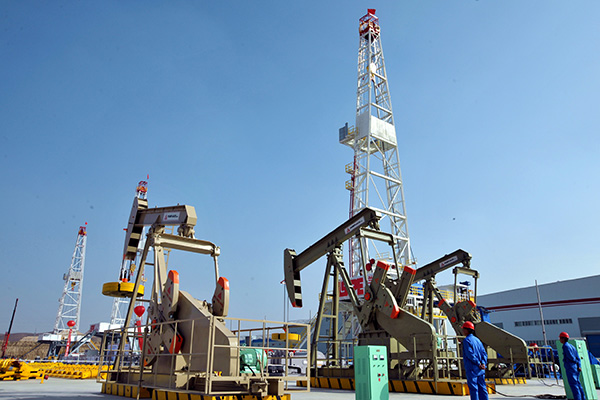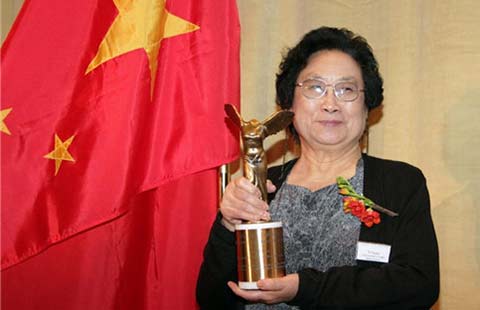Power use, freight volume show positive change amid economic restructuring
Updated: 2015-10-09 20:36
By Wang Bao'an(chinadaily.com.cn)
|
||||||||
 |
|
High-end drilling equipment being tested at Lanzhou LS Group Co Ltd's industrial park. [Photo/China Daily] |
New changes reflect restructuring progress
China's economy has entered "new normal" in recent years, with certain discrepancy between different indicators. When economic growth experiences a slight decline, growth of power use and freight volume dropped rapidly. It does not mean that the logic of economic operation has changed or that the data is questionable. Instead, it reflects that progress has been made in China's structural adjustment and upgrading in the past few years.
First, power consumption slowdown is a result of the growing service sector, accelerating industrial upgrade and improved energy efficiency.
Since 2012, China's economy has been shifting from manufacturing-oriented to service sector-oriented, with the service sector overtaking the secondary to become the largest one. The service sector often consumes less electricity than the manufacturing industry, with per unit of added value in the tertiary industry accounting for less than 20 percent of that in the secondary industry. Therefore, power consumption per unit GDP tends to drop when manufacturing slows and the service sector gains momentum. In 2014, the added value of the tertiary industry accounted for 48.1 percent, 3.9 percentage points higher than that in 2010.
Preliminary calculation proves that power consumption per unit of GDP in 2014 is about 5.4 percent lower than that in 2010, considering only the impact of economic structural changes. In the first half of this year, the added value of the service industry grew 8.4 percent year on year, up from 7.9 percent last year. The manufacturing added value grew 6 percent, down from 7.2 percent a year earlier. Accordingly, the whole society's power consumption increased by 1.3 percent, down from 5.3 percent posted last year.
Industrial upgrade also contributed to the slowing power consumption growth. Electricity demand is stronger in high energy-consuming industries than in high-tech industries whose increasingly larger share in China's economic growth leads to a decline of total industrial power use. Energy-intensive industries often consume more than 60 percent of total industrial electricity. But with their added value dropping, power consumption per added value last year decreased 4.8 percent than that in 2010. At the same time, high-tech development tends to bring down the power consumption.
Meanwhile, slowing power use reflects improvements in energy efficiency and consumption structure, due to government policies that encourage energy conservation and emission reduction, and market forces that drive companies to seek technological innovations and boost energy efficiency. In 2011-2014, energy consumed by per unit copper smelting capacity dropped by 22.6 percent, per ton cement by 12.7 percent, per unit crude oil processing 3 percent, thermal power in standard coal by 3.5 percent, and per ton steel by 6.4 percent. Energy consumption by per unit GDP fell 13.1 percent. Higher energy efficiency to some extent led to the slowdown of electricity consumption, especially the industrial power use. It's estimated that technological upgrade brought down 4.1 percent of the power consumption in all industries last year than in 2010.
Second, freight volume drop resulted from economic restructuring, optimized energy structure, diversified transportation and improved regional productivity layout.
Traditional industries have been transforming rapidly in the economic "new normal", in which weakened demand for commodities and raw materials has led to the decline of railway freight volume. For example, "black commodities" such as coal and steel, which account for more than 85 percent of total freight volume, dropped for the third consecutive year in 2014 and fell further 11.2 percent in the first eight months this year. In 2012-14, coal transportation decreased 79.95 million tons, steel and non-ferrous metal 31.14 million tons and metal ores 24.39 million tons.
The optimization of energy consumption structure has weakened coal demand. In recent years, the proportion of clean energy consumption is increasing. In 2014, consumption of clean energy such as hydro-power, wind power, nuclear power and natural gas accounted for 16.9 percent, 3.5 percent higher than that of 2010. Such development brought down thermal power demand, coal in particular. In 2014, the raw coal accounted for 66 percent of the total energy consumption, 3.2 percent lower than that in 2010. Coal consumption dropped 2.9 percent from a year earlier, for the first time in over a decade.
In addition, the Chinese governm

 Students join outdoor courses in countryside
Students join outdoor courses in countryside
 Stewardesses trained to show sweet smile
Stewardesses trained to show sweet smile
 Tourist attractions receive30 million visitors during Golden Week
Tourist attractions receive30 million visitors during Golden Week
 One killed in Northern Arizona University shooting
One killed in Northern Arizona University shooting
 Top 10 most competitive economies
Top 10 most competitive economies
 Cold wave sweeps through China
Cold wave sweeps through China
 Taking a peek
Taking a peek
 News you don't wanna miss over the National Day holiday
News you don't wanna miss over the National Day holiday
Most Viewed
Editor's Picks

|

|

|

|

|

|
Today's Top News
Tu first Chinese to win Nobel Prize in Medicine
Huntsman says Sino-US relationship needs common goals
Xi pledges $2 billion to help developing countries
Young people from US look forward to Xi's state visit: Survey
US to accept more refugees than planned
Li calls on State-owned firms to tap more global markets
Apple's iOS App Store suffers first major attack
Japan enacts new security laws to overturn postwar pacifism
US Weekly

|

|








